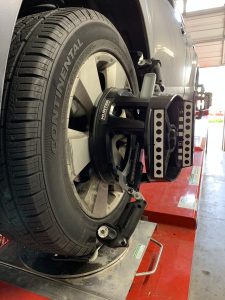
With much anticipated coming of spring, and what looks like a potential light at the end of this Covid situation, many of us in the Pacific Northwest are eager to get our Subaru’s back out on the open road for some Adventures!
So you load up your car, get all your family members buckled in, and off you go. Once your Subaru reaches that open highway, and set that cruise control, you start to notice your vehicle’s steering wheel is a bit off center to one side, and has to be constantly corrected. What’s happening? Why is my Subaru doing this, you may ask.
A better question – When was the last time you had your Subaru Aligned, or at least the Alignment Checked?
What is an Alignment/Alignment Check?
In short, a tire alignment is a fairly forward process, in which your vehicle may require adjustments of the front and/or rear suspension components. This is accomplished by placing your vehicle on a leveled platform, then attaching “alignment heads” to your wheels, and physically measuring the alignment parameters on your vehicle using a laser-based machine. (Unfortunately no sharks with “frickin laser beams” will be used in this process). It is at this point that we can see if there is any need to perform or any adjustments, or if everything is within specification.

Believe it or not, most Tire manufacturers request the alignment on most vehicles be checked every 4,350 miles!
What makes up the different parts of my Subaru’s alignment?
On most vehicle alignments, the two common items that are adjusted are called “Toe” and “Camber”.
Both can be thought of just like your own two feet. Toe represents the forward direction of the tires, and are checked if they are pointed too far out or too far in. Camber is the angle of the vehicle’s wheel(s) when viewed from the front or rear. Think of this as standing on the sides (inner or outer) of your feet, instead of standing on the soles. Then think about how much less of a contact patch your shoe has with the ground when your feet are not planted flat on the ground with your toes ahead of you.
*For those who like a more technical description, see the bullet points below.
The four measurable components of an Alignment are as follows:

When any of these items are out of specification, you have the potential to experience your steering wheel being off center, abnormal tire wear, decreased handling capability, and even decreased fuel economy.
When should I have my tire alignment checked and/or alignment performed?
It is a good idea to have your first alignment check after the vehicle is about two years old, or 25-35K miles. Time has allowed the vehicle suspension to settle in, as well as to be driven in different conditions that could affect alignment. Beyond that, it is recommended to check the alignment every year or 15-20K miles. It is especially important to check the alignment regularly on vehicles with 90k + miles or 6-8+ years old. This is due to the suspension and associated components now starting to age, maybe even sag a little bit, and sit in a different resting position.
There are some situations where your vehicle will likely need an alignment without checking it. That includes when you’ve hit a sizable object on the road or pot hole, you see an abnormal wear pattern developing on your tires, (this will not fix the wear pattern, but help it from getting worse), or anytime you replace major suspension or steering components, including wheel bearings, steering rack assembly or most suspension bushings.
Fortunately, with modern technology, most checks and adjustments are relatively quick and inexpensive. We always want to make sure we keep an eye on your Subaru’s alignment for a comfortable and confident ride, as well as saving you money down the road.
Hope this gives you a little more insight into vehicle alignments, and knowing we are here to help make sure your Subaru drives straight ahead in your next adventure.
Thanks for reading.
– Joe